What Does Href Stand For and How To Fix An Empty Href Issue?
Site Audit Issues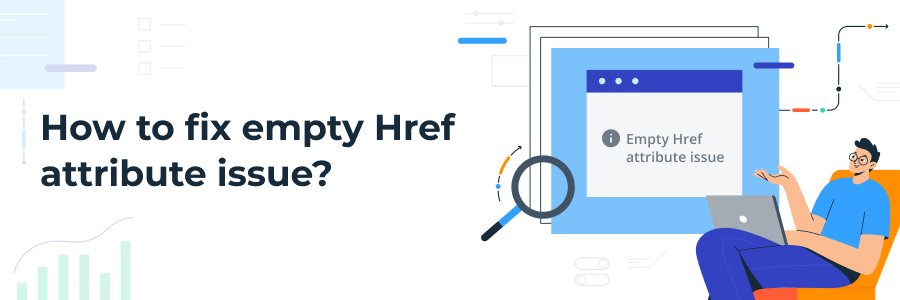
Content:
- What Does Href Mean?
- What Causes an Empty Href Attribute?
- How To Fix an Empty Href Attribute?
- Conduct a Website Audit with Netpeak Spider
- Conclusion
The empty href attribute issue typically occurs when the value inside the href attribute is left blank or absent. This may lead to broken links and difficult website navigation for users. Ensuring that every href attribute in the HTML links is correctly filled is crucial to solving this issue.
So, what is the href meaning in SEO? You may also wonder what causes the empty href issue and how to fix it. We’ll find out it all with the Netpeak Spider below!
What Does Href Mean?
So what does href do? The href attribute specifies the URL of the page that it leads to. However, without the href attribute, the <a> tag will not be a hyperlink. A hyperlink uses the <a> tag and HTML code's href SEO attribute, making links clickable. Basically, to add such a link in HTML, you would use the <a href="targeted link"> code, where "targeted link" refers to the URL of the desired page. When the end user clicks on the text, they will be redirected to the page link provided by the href.
And what does a href mean in HTML? The href link comprises the <a> tag, href attribute, and anchor text. Let’s look at this example from the "What SEO Audits You Can Do in Netpeak Spider" article. The ‘XML sitemap validator’ quote has a hyperlink:

The HTML code for this link represents as follows, where the underlined part is our href SEO attribute:
According to search engine optimization, a blank href (or that only contains spaces) creates errors. An empty href means a URL includes at least one external anchor link with an empty href attribute.
What Causes an Empty Href Attribute?
An empty href attribute error happens when any internally indexed URL has at least one external link without the href attribute or with spaces only. If the href attribute of an HTML tag is empty, the redirection for the targeted link won’t be possible. This problem may result from a technical issue or human error. Here is a complete list of potential causes:
- Coding Mistakes: When writing the HTML code, sometimes developers fail to insert a valid URL or reference in the href attribute.
- Incomplete HTML code: In the development process, links may be inserted as placeholders without specifying the URLs. This means the href attribute may be left blank until the end product is finished.
- Content Loading Automation: You may use JavaScript or scripting languages to populate links dynamically and automatically. If the script code or data fetching process is faulty, the href attribute may be empty.
- Template Errors: Sometimes developers copy or use templates for web pages and may fail to change some attributes, such as empty href. This can lead to the default value.
- Backend Data Errors: Empty href attribute can result from data retrieval or storage issues if a website uses a backend CMS or database to create links.
How To Fix an Empty Href Attribute?
To resolve the problem of an empty href attribute in HTML, consider the following steps:
- Use a valid link
Change the empty href attribute with a valid URL or an internal link. For example, <a href="https://www.google.com">Google</a>, where Google is a clickable term.

- Remove the empty href attribute
If the link is created to have no destination, consider removing the href attribute. This is appropriate for links that activate JavaScript actions or are used for styling purposes without redirecting to a different page, like <a>Google</a>.
- Inspect JavaScript code
If the link on the page is supposed to be dynamically generated or populated through JavaScript, ensure that JavaScript appropriately creates the URL, for instance: <a href="javascript:void(0);" onclick="myFunction()">Google</a>.
- Dynamic content creation
Examine your data fetch process thoroughly when the links are loaded dynamically from the backend or through scripting. This step will help you avoid many internal errors.
- Edit used templates
Ensure that you have updated the href attribute with the correct values for the used templates or copy code.
- Validate backend data
When the links are populated from backend data, it is crucial to ensure that the data is stored and retrieved correctly to prevent an empty href attribute issue.
- Regular website audit
Incorporate regular website check-ups to quickly identify and resolve any SEO issues in your internal coding.
Try some of these steps to resolve the empty href SEO issue, ensure that your links serve their intended purpose, and improve the user experience on your website!
Conduct a Website Audit with Netpeak Spider
As mentioned above, a regular website audit is a time saver for locating and fixing your website's possible SEO issues. You don’t need to manually check everything since there is already an all-in-one solution! Here are some of the Netpeak Spider’s crawler features that will be of great help.
External Linking Audit
The process of internal linking optimization is fundamental. At the same time, improving external links is just as important. A thorough audit will help you find poor external links, broken links, and links that point to pages with long server response times.
Here is how you can proceed with external links check-up in Netpeak Spider:
- Allow crawling of the external links in the app:
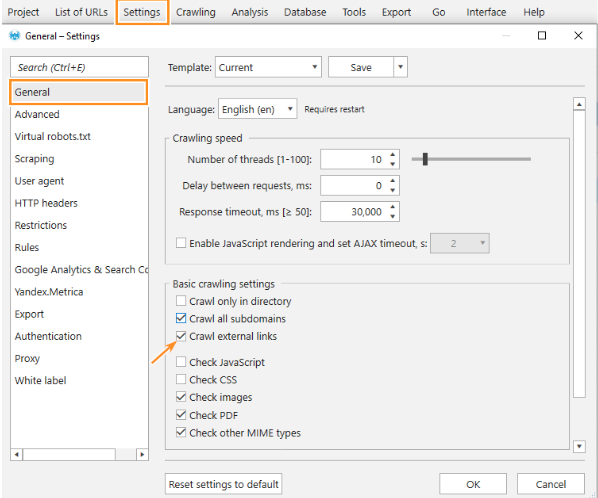
- Select the 'Status Code' and 'Response Time' parameters. After crawling is complete, apply the segment for external links.
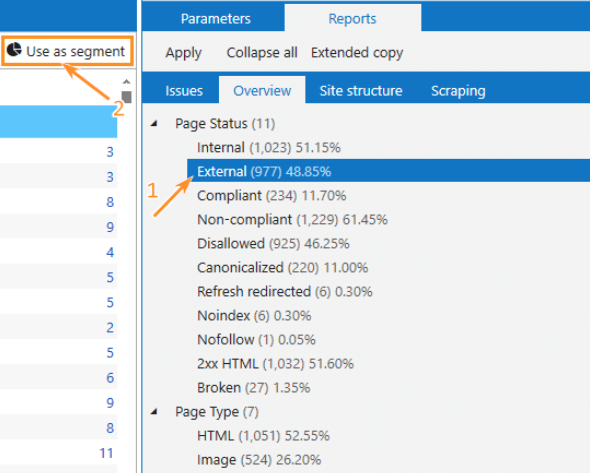
- Select the 'Status Code' and 'Response Time' parameters. After crawling is complete, apply the segment for external links.
Eventually, you will get a complete collection of all the external links and reports showing any problems highlighted on the pages that your website is connected to.
Optimization Priority Audit
To find the pages that receive a low volume of organic traffic compared to paid traffic, you can conduct two research tasks.
- Compare the traffic received by organic and paid pages
- Find pages ranked poorly with Google Search Console
Firstly, add your Google account to Netpeak Spider. After you add the account, start by crawling the website or uploading the URLs from Google Analytics through the "List of URLs" menu.
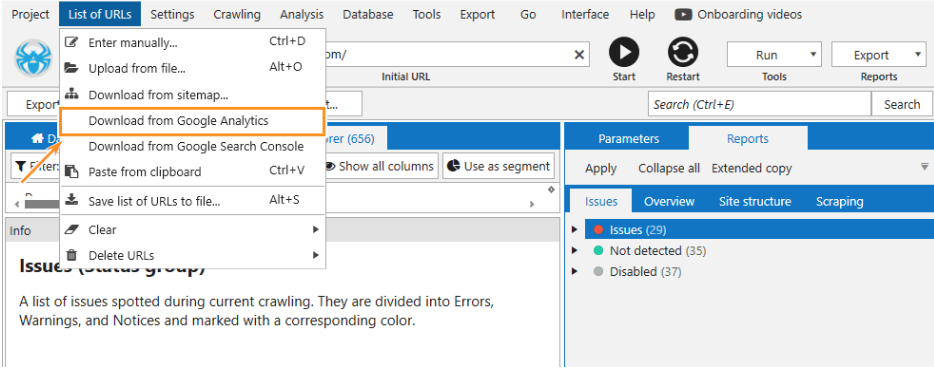
Afterward, pick the paid traffic option in the Google Analytics settings segment dropdown menu. This will help to focus on the pages that receive a lot of paid traffic compared to organic traffic.
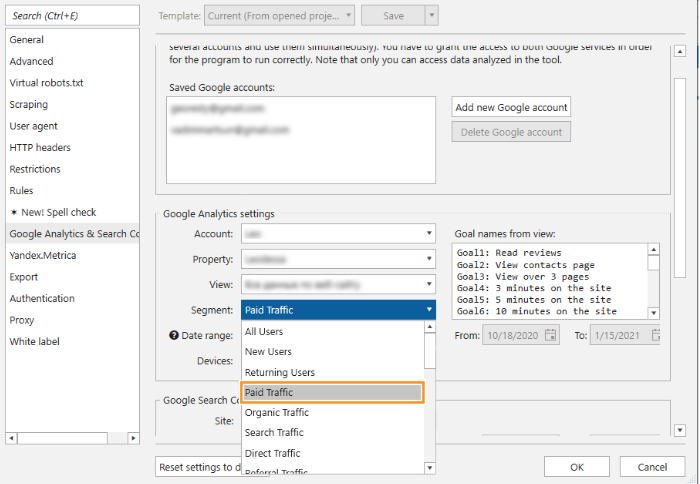
From the "Analysis" menu, export the session data into the main table and create a report based on it. Perform the same steps but set the segment settings to "Organic traffic." Export the session data and make the second report.
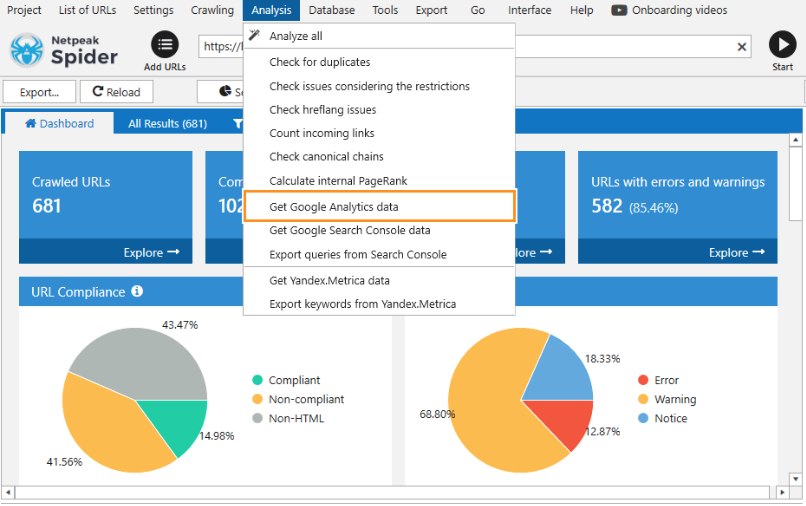
Integrate the two reports and compare the paid and organic traffic share. This analysis will help you identify which pages need more paid traffic than organic traffic.
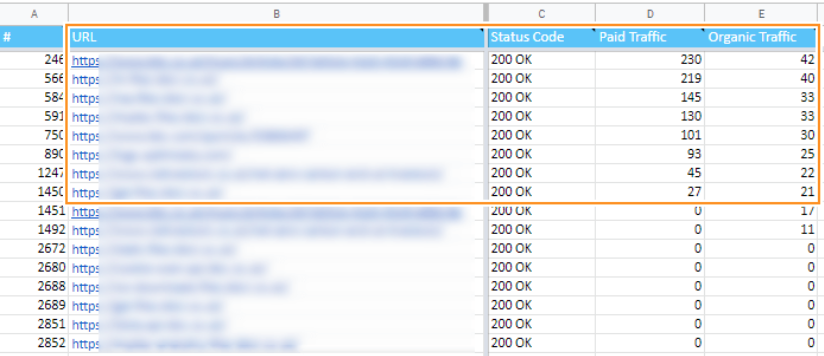
The second task is adding the crawled URLs to a new project in Netpeak Spider. Choosing the ‘GSC: Average Position’ parameter will give you essential information about the website's ranking in the Google Search Console.
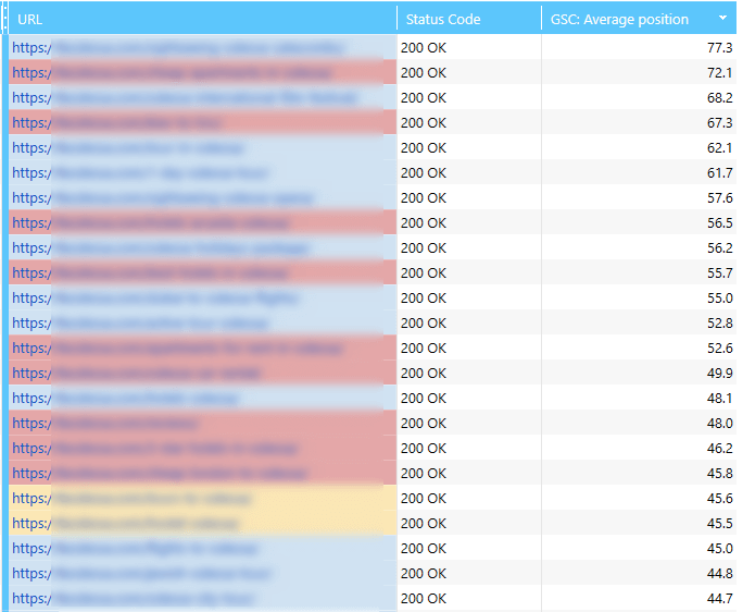
Dashboards and Reports
Use Netpeak Spider for web crawling and get essential diagrams and informative dashboards, as well as easily export and share the project’s ‘health score’. The program tables handle large datasets with features like grouping, sorting, and custom filters. More than 100 SEO issues are color-coded and come with detailed fix descriptions. The crawl data assists in giving information on page status and file types.
With Netpeak Spider, you can also find information about the project site structure and create competitor analysis reports. The software has scraping features to gather website information, such as prices, reviews, SEO texts, tags, and publication dates. The results can be filtered for an in-depth analysis.
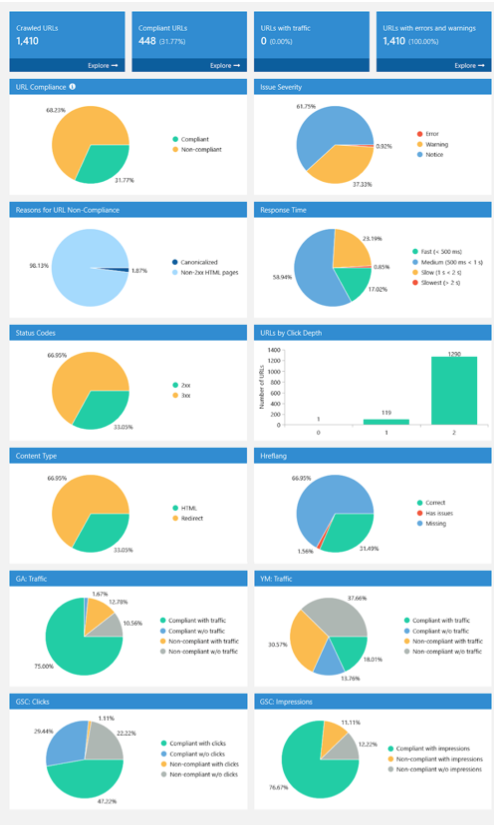
Conclusion
So, let’s review: what does a href do in HTML links? The <a> anchor's href attribute determines the URL of the linked resource, enabling users to navigate to a different webpage, which is an integral part of web design and development. An empty href # meaning boils down to broken links and a bad user experience.
Fortunately, there are practical solutions that we described in this article. No matter what you choose, using a valid link, removing the href attribute, examining JavaScript code, or dynamic content creation will improve website usability.
Don’t forget that all SEO issues are detected and corrected through regular website audits! Tools such as Netpeak Spider provide broad-scope audits with various features, enabling you to enhance SEO performance. Such solutions not only solve the empty href attribute issue but also improve user experience in general!



.png)
